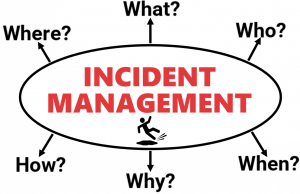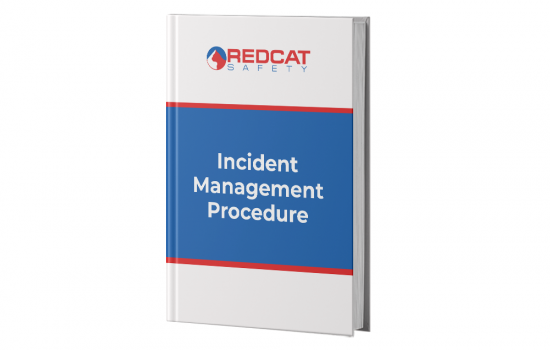What is Incident Management?
Incident management is the process an organization uses to deal with unplanned events or ‘incidents.
In the workplace, incident management is important for several reasons. First, it helps ensure the safety of employees and others who may be affected by an incident. Second, it helps minimize the impact of an incident on the organization’s operations. And third, it helps the organization learn from incidents and improve safety compliance in the future.
The management of incidents includes immediate actions, notification, reporting, recording, investigation and corrective action associated with health, safety, environmental, operational, security and information technology incidents.
Management actions taken in response to an incident are to initially protect and minimize the impact on persons, environment, facilities, production and the community and the corrective actions implemented following an incident shall eliminate or reduce the likelihood of a reoccurrence.
Who Has Overall Responsibility for Managing an Incident?
There are many different incident management systems and approaches however, it is the role of an organization’s management (or their designated incident investigator/commander) to ensure that all activities related to a workplace incident are coordinated and that resources are available and used effectively to achieve incident objectives.
A designated incident investigator/commander will be responsible for the overall management of an incident and will have the authority to make decisions regarding the response to an incident.
The incident investigator/commander may delegate certain tasks to other members of the incident response team but will remain ultimately responsible for the coordination and the response to the incident and will need to report all findings to management.
For serious workplace incidents or major incidents, a government authority or external regulatory body may become involved in the incident investigation.
Management responsibilities with incident management may include:
- Ensuring that processes and resources are available to enable the full reporting, investigation, action and review of all workplace incidents.
- Ensuring that prescribed and notifiable incidents are reported to external regulatory bodies when required by statutory regulations.
- Implementing and following the policies and procedures for the management of incidents to meet company and legal obligations to resolve the incident.
- Ensuring all persons assigned to undertake investigations are competent to do so.
- The collection, maintenance and analysis of incident investigation reports and the
Management actions taken in response to an incident should be to protect and minimize the impact on persons, environment, service operations, facilities, production and the community.
Note: The corrective actions implemented following an incident should be focused on eliminating or reducing the likelihood of a reoccurrence.
Workplace Incident Investigations
Every incident that occurs at a workplace should be investigated to determine exactly how it occurred and identify the contributing factors. It is important to determine an initial diagnosis and what action can be taken to prevent similar incidents.

A person or team should be nominated with the responsibility of undertaking an investigation, as soon as possible. This person or team must be selected based on their training, experience and their knowledge of the workplace and work practices.
Safety related incidents must be investigated using a thorough investigation methodology, to ensure all contributing factors and the root/system causes are identified.
Witness statements and interviews should be taken as soon as possible following an incident unless this is not possible due to a serious condition. Witnesses must be separated (if required) to enable statements to be obtained without influence.
A preliminary incident report should be drafted within 24 hours of an injury and forwarded to management, as soon as possible.
Corrective and preventative actions should be established based on investigation findings and should be actioned as soon as reasonably practicable to prevent a recurrence. All corrective actions must be monitored after implementation to ensure they are effective.
Records of all incident investigations and corrective actions must be retained following best practices and legal obligations. Formal incident reports should be retained as ‘documented information.’
Contents of this Incident Management Procedure
- Approval.
- Purpose.
- Scope and Objectives.
- Terms and Definitions.
- Roles and Responsibilities.
- Procedures.
- Incident Management Process Overview.
- Incident Management Process Flowchart.
- Immediate Actions After an Incident Occurs.
- Duty to Preserve Incident Sites.
- Defined incidents and Incident Prioritization.
- Reporting Incidents.
- Incident Investigation and Incident Resolution.
- Reporting Process and Duty to Notify.
- Incident Categorization and Data Analysis.
- Monitoring of Actions and Incident Closure.
- Statutory Reporting.
- Communication and Training.
- Privacy of Personal Information.
- Related Procedures, Forms and Documents.
- Review Criteria.
- Record Management.
- References.
Why Choose to Buy this Incident Management Procedure
This 14-page incident management procedure template can assist you develop and maintain methods for responding to incidents that result in injury or damage.
The procedure defines many (or all) of the responsibilities and accountabilities that can ensure incidents are responded to, investigated and reported appropriately.
Additionally, this procedure enables records and statistics regarding incidents to be maintained and legal obligations to be met. It can also enable management to predict and prevent the recurrence of similar incidents by the study of trends, cause and effect.
After purchasing this template you will be able to:
- Very easily edit and customize the template to create your own procedure.
- Apply your own style, format and brand to the procedure.
- Use it in any industry or sector regardless of the size or type of organization.
Availability and Use of this Incident Management Procedure
- This procedure is accessible to you right now by clicking the ‘Buy Now’ button.
- The procedure will be delivered to you in fully editable Microsoft Word format for immediate and full use in your business.
- There are no subscriptions, contracts or ongoing costs.
This Incident Management Procedure is 100% Satisfaction Guaranteed.


